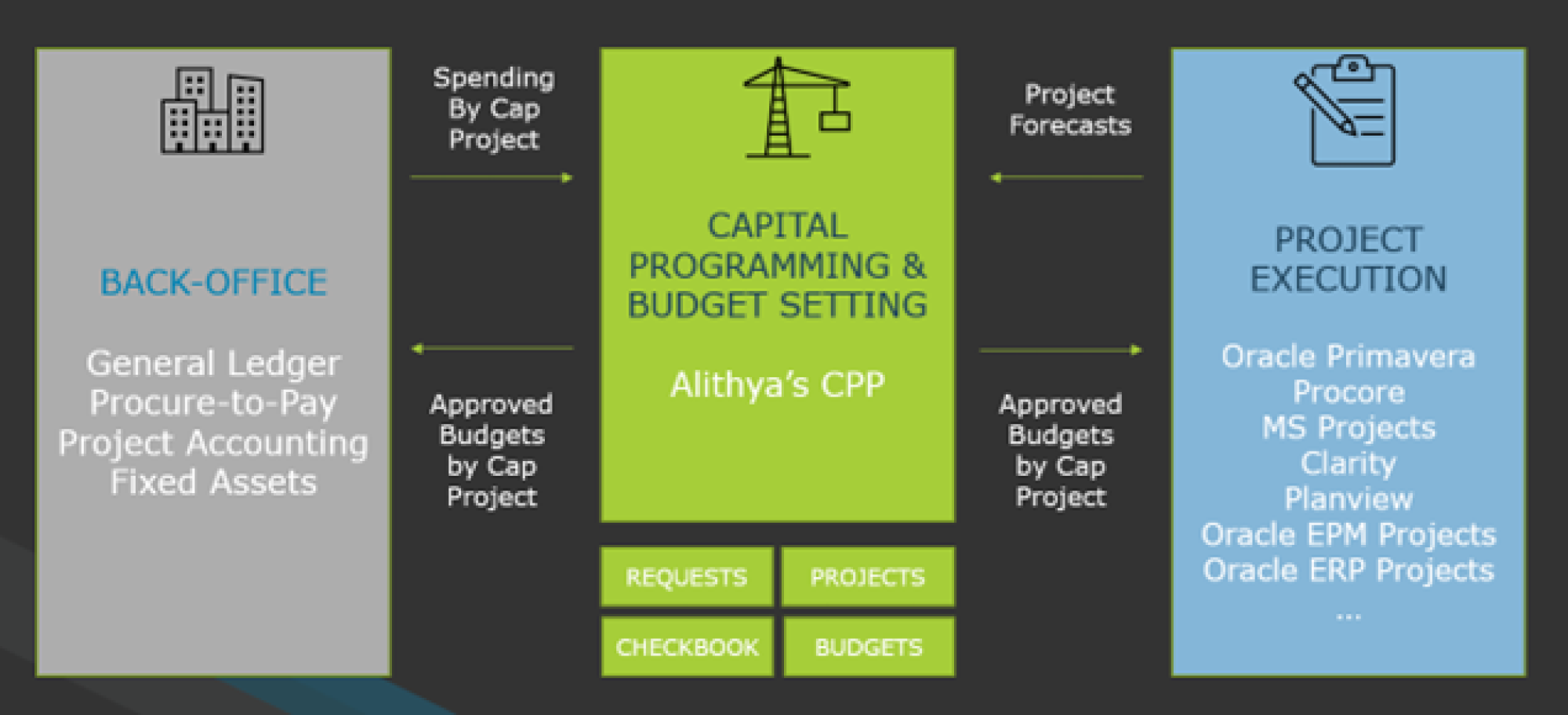An "Integrated Capital Cycle" sounds official. But, for those who live in these interrelated business processes, it's a fancy way of explaining the three symbiotic processes that support the acquisition and construction of things like IT systems, buildings, and equipment. An Integrated Capital Cycle takes a business investment idea and converts it to real-world action by coordinating with your internal and external teams to get something built.
There are three major processes to consider with an Integrated Capital Cycle:
- Capital Programming & Budget Setting
- Back Office
- Project Execution

Capital Programming & Budget Setting
Capital programming starts by asking your business managers & leaders to build their investment roadmaps for their parts of the business. At most organizations I work with, each manager has a spreadsheet that lists projects they want to do over the next few years: equipment that needs to be replaced, products they want to introduce, and so on.
When the budget season starts, Finance asks leaders to submit their list of asks for next year into the budget request process. The business leader will take the next batch of items from their spreadsheet and submit it to Finance. Finally, a Finance person compiles a list and brings it to their capital committees for approval. It's all request forms, excel, email, and PowerPoint, and generally painful for everyone involved. It's handled chiefly via email and phone calls.
At Alithya, we've institutionalized this capital programming and budget-setting process using Oracle's EPM Planning Cloud to deploy a turnkey capital request, prioritization, and budget-setting process. We call it Alithya's Capital Portfolio Planning (CPP). CPP provides the request forms, workflow, and a centralized database to manage the overall capital programming process.
Project Execution
Once you have determined a set of approved capital projects, you need to execute these capital investments.
The second pillar of an Integrated Capital Cycle is Project Execution. This is where the rubber hits the road.
Your project managers need to:
- Set detailed project budgets by vendor & activity.
- Coordinate with vendors like architects, surveyors, and construction.
- Coordinate contracts & permits.
- Manage schedules & timelines.
- Capture workers' timesheets & expenses.
- Schedule workers & shifts.
The tools people use vary by type of project:
- Construction-oriented projects, such as building a $50M facility, require tools geared to complex construction projects: tools like Oracle's Primavera or Procore that facilitate managing contracts, vendors, workers, and schedules.
- Alternatively, IT PMOs often use project management tools like Clarity, Planview, or Oracle ERP Projects.
- And for all the projects in-between, we see plenty of teams using Microsoft Projects and SmartSheet!
Regardless of what Project Execution tool your organization uses, the linkage between processes is critical. For example, Alithya's Capital Portfolio Planning will inform the Project Execution tools of the approved budget, and conversely, the Project Execution tools will inform CPP of their estimate-to-completes.
Back Office
The third pillar of an Integrated Capital Cycle authorizes procurement, pays your vendors, and keeps the [accounting] books current.
When a business leader is ready to start procurement for a new capital project, they will create a Funding Request in Alithya's CPP. When this funding request gets approved, CPP informs your procurement tools about the new project and its budget. From then on, the leader can create purchase orders and pay vendor invoices. As POs and invoice payments occur, your back-office tools communicate the actuals to Alithya's CPP so you can monitor your project's real-time actual vs. budget health.
When a specific capital project needs more funding, the business leader can initiate a Funding Change Request against the capital project in Alithya's CPP. If additional funds are approved, the additional budget is automatically updated in your back-office tools, allowing for increased budgetary limits for purchase orders and invoice payments.
Finally, all projects will come to an end, and that project's newly created assets must be placed into service. We initiate project closure in Alithya's Capital Portfolio Planning. When a project is closed, any remaining budget is released to the organization, and the back-office tools are informed to prevent additional procurement. The back-office tools will convert the accrued project CIP/WIP cost into in-service assets within your Fixed Assets ledger.
Often, we will work with many different back-office tools, such as Oracle's Cloud ERP, when implementing Alithya's Capital Portfolio Planning. Oracle's EPM Cloud easily integrates with them using its open data integration capabilities. Alithya is an implementor and user of Oracle's Cloud ERP, and we often implement procurement, purchasing, project accounting, and fixed assets ledger solutions.
Alithya Can Build Your Integrated Capital Cycle
Please contact Alithya if you need assistance designing a modern Integrated Capital Cycle and would like to speak to our back office or capital programming architects.
For comments, questions, or suggestions for future topics, please reach out to us at [email protected]. Visit our blog regularly for new posts about Cloud updates and other Oracle Cloud Services such as Planning and Budgeting, Financial Consolidation, Account Reconciliation, and Enterprise Data Management. Follow Alithya on social media for the latest information about EPM, ERP, and Analytics solutions to meet your business needs.
